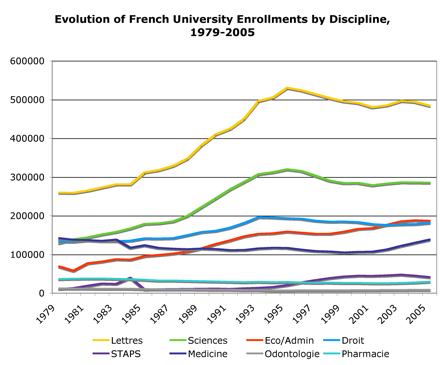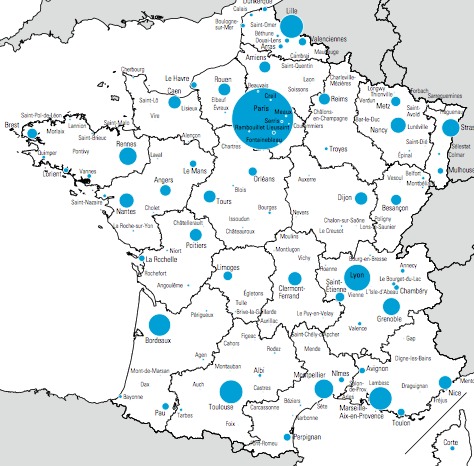If you want to get a sense of the overall institutional situation of French universities, it helps to look at how many French students are studying what. In this post I just want to present a basic, broad overview of the situation.
There’s a lot to see here. You can see what sociologists call the “second massification” of the universities, a period of major growth from something like 1985-1995. Almost every discipline is rising. The largest disciplines are not, actually, the ones with the most growth. That dubious honor goes to the field called STAPS, which stands for Sciences et Techniques des Activités Physiques et Sportives, which we could translate loosely as Athletic Sciences. STAPS grew from 10,947 enrolled students in 1979 to 41553 in 2005 — a 3.8-fold increase! The similarly tiny fields of dentistry (odontologie) and pharmacy, on the other hand, actually shrunk, though you can barely see them because they get lost in the bottom of the graph.
Let’s look more closely at the major disciplines. Letters and human sciences here are labeled lettres; they’d probably be called humanities and social sciences in the U.S. Anyway, it’s striking that they constitute the largest sector of French higher education, with around half a million enrollees. They have almost doubled in size since the 1980s, though they have also been in a steady, slow absolute decline since the mid-nineties. The sciences are smaller, but show a similar trend. The business-oriented disciplines of Eco (here short for Sciences Economiques) and Admin (Administration économique et sociale) have grown somewhat more, by a factor of 2.7, and seem to have on the whole one of the most consistent, steady rises of any field. Law (droit), which presumably leads to both private and public-sector careers but at any rate to a secure professional identity, has grown somewhat and leveled off, while its cousin medicine has on the whole slightly declined. (Law and medicine are the two most traditional professional fields in the traditional French university.)
Continue reading “Disciplinary evolution in French universities”

